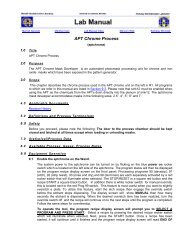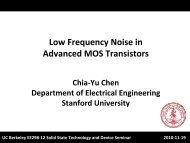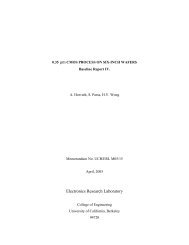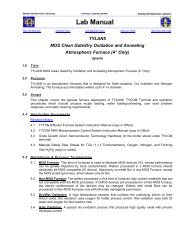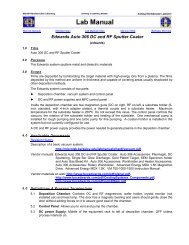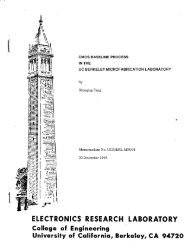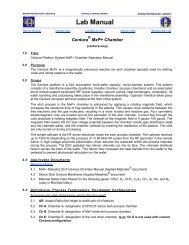Fully depleted, back-illuminated CCDs for ... - Berkeley Microlab
Fully depleted, back-illuminated CCDs for ... - Berkeley Microlab
Fully depleted, back-illuminated CCDs for ... - Berkeley Microlab
Create successful ePaper yourself
Turn your PDF publications into a flip-book with our unique Google optimized e-Paper software.
<strong>Fully</strong> <strong>depleted</strong>, <strong>back</strong>-<strong>illuminated</strong><br />
<strong>CCDs</strong> <strong>for</strong> astronomy and astrophysics<br />
Steve Holland<br />
Fermi National Accelerator Laboratory<br />
Dark Energy Survey Camera (DECam)<br />
570 Mpixel camera consisting of 74,<br />
250 µm thick, fully <strong>depleted</strong> <strong>CCDs</strong><br />
Teledyne DALSA/LBNL<br />
1 st light Fall 2012
Outline<br />
• Fundamentals of <strong>CCDs</strong> and CMOS image sensors<br />
• Scientific <strong>CCDs</strong> <strong>for</strong> astronomy<br />
• <strong>Fully</strong> <strong>depleted</strong> <strong>CCDs</strong> fabricated on high-resistivity<br />
silicon – device physics/applications/technology
Scientific <strong>CCDs</strong> vs cell phone imager<br />
Unofficial comparison, scientific CCD versus CMOS image<br />
sensor <strong>for</strong> cell phones (e.g. iPhone 4, TSMC/OmniVision 1 )<br />
Parameter CMOS cell phone Scientific CCD<br />
# pixels 5 - 8 Megapixels 8 – 16 Megapixels<br />
Pixel size 1.4 – 1.7 µm 10 – 15 µm<br />
Imaging area 15 mm 2 (5M) 3775 mm 2 (16M)<br />
Technology 130 nm CMOS 2.5 µm CCD<br />
Illumination Back illumination Back illumination<br />
Optical thickness ~ 3 µm 10 – 250 µm<br />
Peak QE ~ 55% (color filter) ~ 90 – 95%<br />
Operating temp Up to 50°C -100°C – -140°C<br />
Dark current 20 – 30 e-/pixel/sec Few e-/pixel/hr<br />
Read noise ~ 2 e- ~ 2-5 e-<br />
Full well ~ 4500 e- ~ 200,000 e- (15 µm)<br />
1 Rhodes, 2009 IISW Symp. On Backside Illumination of Solid-State Image Sensors, imagesensors.org and<br />
http://image-sensors-world.blogspot.com/2010/06/iphone-4-bsi-sensor-is-omnivisions.html
Scientific <strong>CCDs</strong> vs cell phone imager<br />
Unofficial comparison, scientific CCD versus CMOS image<br />
sensor <strong>for</strong> cell phones (e.g. iPhone 4, TSMC/OmniVision 1 )<br />
Parameter CMOS cell phone Scientific CCD<br />
# pixels 5 - 8 Megapixels 8 – 16 Megapixels<br />
Pixel size 1.4 – 1.7 µm 10 – 15 µm<br />
Imaging area 15 mm 2 (5M) 3775 mm 2 (16M)<br />
Technology 130 nm CMOS 2.5 µm CCD<br />
Illumination Back illumination Back illumination<br />
Optical thickness ~ 3 µm 10 – 250 µm<br />
Peak QE ~ 55% (color filter) ~ 90 – 95%<br />
Operating temp Up to 50°C -100°C – -140°C<br />
Dark current 20 – 30 e-/pixel/sec Few e-/pixel/hr<br />
Read noise ~ 2 e- ~ 2-5 e-<br />
Full well ~ 4500 e- ~ 200,000 e- (15 µm)<br />
Cost
CCD 101 – Invention<br />
• Invented by W. Boyle and G. Smith (Bell Laboratories) on<br />
September 8 th , 1969 – Awarded Nobel Prize in Physics 2009<br />
• Tasked by Jack Morton to find a semiconductor analogy to<br />
the magnetic “bubble memory”<br />
• The basic concepts were conceived in a discussion session<br />
between Boyle and Smith “lasting not more than an hour” 1-3<br />
[1] G.E. Smith, “The invention and early history of the CCD,” J. Appl.<br />
Phys., 109, 102421, 2011.<br />
[2] W.S. Boyle and G.E. Smith, “The inception of charge-coupled<br />
devices,” IEEE Trans. Elec. Dev., 23, 661, 1976.<br />
[3] G.E. Smith, “The invention of the CCD”, Nucl. Instrum. Meth. A,<br />
471, 1, 2001.
CCD 101 – Boyle/Smith notebook entry<br />
• Collection and storage of charge in MOS capacitor depletion regions<br />
— Dashed line denotes edge of depletion region<br />
— + denotes storage of charge (holes in this case)<br />
• Charge transferred via clocking of closely spaced electrodes<br />
3-phase CCD diagram (lab notebook drawing Sept. 1969)
2D simulation of charge shift in CCD
Poly 2<br />
Poly 1<br />
CCD 101 – Triple poly process<br />
Scientific <strong>CCDs</strong> typically use the same 3-phase clocking<br />
as in the original Boyle and Smith concept with<br />
overlapping polysilicon gate electrodes (triple poly)<br />
Poly 3
CCD 101<br />
UC-<strong>Berkeley</strong> connections to CCD development<br />
IEEE Trans. Elec. Dev., 21, 712, 1974<br />
Carlo Sequin, UC-<strong>Berkeley</strong> Professor of Computer Science since 1977
CCD 101<br />
For maximum quantum efficiency<br />
scientific <strong>CCDs</strong> are <strong>back</strong> <strong>illuminated</strong>
Front vs Back illumination – <strong>CCDs</strong><br />
Front illumination: Quantum efficiency loss from<br />
• Absorption in polysilicon gates<br />
• Reflections from complicated thin film stack<br />
Back illumination (thinned <strong>CCDs</strong>):<br />
• Remove p+ substrate<br />
• Limited depletion depth <strong>for</strong><br />
typical resistivity silicon implies<br />
significant thinning (10 – 20 µm<br />
<strong>for</strong> scientific <strong>CCDs</strong>, ~ 3 µm <strong>for</strong><br />
CMOS image sensors)
Sloan Digital Sky Survey<br />
CCD quantum efficiency<br />
versus wavelength comparing<br />
1) Back illumination<br />
2) Front illumination<br />
Front vs Back illumination – <strong>CCDs</strong>
CCD vs CMOS image sensor<br />
• <strong>CCDs</strong>: Shifting of charge vertically and horizontally to a<br />
source follower amplifier that converts charge to voltage<br />
• CMOS image sensors have an SF amplifier in each pixel<br />
eliminating the need <strong>for</strong> high charge-transfer efficiency<br />
A. Theuwissen, IEEE Solid-State<br />
Circuits Magazine, 22, Spring 2010
CCD 101 – CMOS image sensor<br />
• CMOS image sensors incorporate pinned photodiodes 1 to<br />
suppress surface dark current and floating diffusion amplifiers<br />
• kTC noise suppression – Borrowed from <strong>CCDs</strong><br />
A. Theuwissen, IEEE Solid-State<br />
Circuits Magazine, 22, Spring 2010<br />
Takayanagi and Nakamura, to<br />
appear in IEEE Proceedings<br />
1 N. Teranishi et al, IEEE Trans. Elec. Dev., 31, 1829, 1984<br />
Analogous to buried channel<br />
CCD potential profile
Front vs <strong>back</strong> illumination – CMOS<br />
• CMOS image sensors with small pixels need <strong>back</strong><br />
illumination simply to get the light into the pixel<br />
IBM front <strong>illuminated</strong> CMOS image sensor<br />
2.2 µm pixel<br />
2006 IDEM (Gambino et al)<br />
Sony <strong>back</strong> <strong>illuminated</strong> CMOS image sensor<br />
1.65 µm pixel<br />
2010 ISSCC (Wakabayashi et al)
Outline<br />
• Fundamentals of <strong>CCDs</strong> and CMOS image sensors<br />
• Scientific <strong>CCDs</strong> <strong>for</strong> astronomy<br />
• <strong>Fully</strong> <strong>depleted</strong> <strong>CCDs</strong> fabricated on high-resistivity<br />
silicon – device physics/applications/technology
Scientific <strong>CCDs</strong> <strong>for</strong> Astronomy<br />
• Scientific charge-coupled devices are the detector of<br />
choice <strong>for</strong> astronomy applications in the UV, visible<br />
and near-infrared wavelengths<br />
λ ~ 350 nm to about 1.1 µm (atmospheric cutoff to Si bandgap)<br />
— Back <strong>illuminated</strong> <strong>for</strong> high quantum efficiency<br />
> 90% peak<br />
— Slow readout <strong>for</strong> low noise<br />
< 5 e- typically at 100 kpixels/sec readout
Scientific <strong>CCDs</strong> <strong>for</strong> Astronomy<br />
• Scientific charge-coupled devices (cont’)<br />
—Cryogenically cooled <strong>for</strong> low dark current<br />
Few electrons/pixel-hour at -100 to -140ºC<br />
—Large <strong>for</strong>mat with large pixels<br />
10 – 15µm pixels, 4k x 4k and larger<br />
—Very $$$<br />
Examples of astronomy cameras follow
120 Mpixels<br />
CCD cameras <strong>for</strong> astronomy<br />
SDSS Photometric Camera – 30 2k x 2k, (24 µm) 2 -pixel <strong>CCDs</strong><br />
Sloan Digital Sky Survey Telescope / 2000 – 2008<br />
Thinned (~ 10 – 20 µm thick), partially <strong>depleted</strong> <strong>CCDs</strong> from SITe
CCD cameras <strong>for</strong> astronomy<br />
~ 6 cm<br />
~ 3 cm<br />
340 Mpixels<br />
MegaCam – 36 2k x 4k, (15 µm) 2 -pixel <strong>CCDs</strong><br />
Canada-France-Hawaii Telescope / 2003<br />
256 Mpixels<br />
OmegaCAM – 32 2k x 4k, (15 µm) 2 -pixel <strong>CCDs</strong><br />
ESO VLT Survey Telescope (VST)<br />
1 st light June 2011<br />
Thinned (~ 10 – 20 µm thick), partially <strong>depleted</strong> <strong>CCDs</strong> from e2V
64 Mpixels<br />
CCD cameras <strong>for</strong> astronomy (cont’)<br />
SuprimeCam – 8 2k x 4k, (15 µm) 2 -pixel <strong>CCDs</strong><br />
Subaru 8-m Telescope (1998)<br />
PS1 camera – 60 4.8k x 4.8k, (10 µm) 2 -pixel <strong>CCDs</strong><br />
Pan-STARRS telescope (2010)<br />
~ 40 µm thick, partially <strong>depleted</strong> and ~ 75 µm thick, fully <strong>depleted</strong> <strong>CCDs</strong><br />
(deep depletion <strong>CCDs</strong>)<br />
MIT Lincoln Laboratory<br />
1.4 Gpixels
CCD cameras <strong>for</strong> astronomy (cont’)<br />
84 Mpixels<br />
SuprimeCam – 10 2k x 4k, (15 µm) 2 -pixel <strong>CCDs</strong><br />
Subaru 8-m Telescope (2008)<br />
~ 200 µm thick, fully <strong>depleted</strong> <strong>CCDs</strong><br />
Hamamatsu Corporation<br />
870 Mpixels<br />
HyperSuprimeCam – 116 2k x 4k, (15 µm) 2 -pixel <strong>CCDs</strong><br />
Subaru 8-m Telescope<br />
1 st light achieved 28Aug2012
Coming soon – Fermi National Accelerator<br />
Laboratory Dark Energy Survey Camera<br />
520 Mpixels<br />
Dark Energy Survey Camera (DECam) – 62 2k x 4k, (15 µm) 2 -pixel <strong>CCDs</strong><br />
NOAO Cerro Tololo Blanco 4-m Telescope (Fall 2012)<br />
250 µm thick, fully <strong>depleted</strong> <strong>CCDs</strong> (DALSA/LBNL)
Credit: CTIO/AURA/NSF<br />
Artist’s rendering – Cerro Tololo Inter-American<br />
Observatory V. M. Blanco 4-m telescope (Chile)<br />
Coming soon – Fermi National Accelerator<br />
Laboratory Dark Energy Survey Camera
Coming soon – Fermi National Accelerator<br />
Laboratory Dark Energy Survey Camera
Coming soon – Fermi National Accelerator<br />
Laboratory Dark Energy Survey Camera<br />
DECam's imager is visible <strong>for</strong> the last time (blue, left of center) be<strong>for</strong>e it is<br />
inserted into the instrument, meeting the optical corrector <strong>for</strong> the first time.<br />
Image credit: T. Abbott CTIO/NOAO/AURA.
… is an international project to “nail<br />
down” the dark energy equation of state.<br />
119+ scientists<br />
12+ institutions<br />
DES Collaboration<br />
CTIO<br />
Fermilab, UIUC/NCSA, University of Chicago,<br />
LBNL, NOAO, University of Michigan, University<br />
of Pennsylvania, Argonne National Laboratory,<br />
Ohio State University, Santa-Cruz/SLAC<br />
Consortium, Texas A&M<br />
LMU<br />
UK Consortium:<br />
UCL, Cambridge, Edinburgh,<br />
Portsmouth, Sussex<br />
Ludwig-Maximilians Universität<br />
Spain Consortium:<br />
CIEMAT, IEEC, IFAE<br />
Brazil Consortium:<br />
Observatorio Nacional,<br />
CBPF,Universidade Federal do Rio de<br />
Janeiro, Universidade Federal do Rio<br />
Grande do Sul
Outline<br />
• Fundamentals of <strong>CCDs</strong> and CMOS image sensors<br />
• Scientific <strong>CCDs</strong> <strong>for</strong> astronomy<br />
• <strong>Fully</strong> <strong>depleted</strong> <strong>CCDs</strong> fabricated on high-resistivity<br />
silicon – device physics/applications/technology
<strong>Fully</strong> <strong>depleted</strong>, <strong>back</strong>-<strong>illuminated</strong> CCD<br />
1) Concept: Fabricate a conventional CCD on a<br />
thick, high-resistivity Si substrate (> 4 kΩ-cm)<br />
200-250 µm typical<br />
2) Use a substrate bias voltage to fully deplete the<br />
substrate of mobile charge carriers<br />
Merging of p-i-n and CCD technology<br />
High-ρ Si allows <strong>for</strong> low depletion voltages<br />
Float-zone refined silicon
High-resistivity silicon 101<br />
Standard silicon is produced by<br />
the Czochralsky method:<br />
The ingot is pulled from molten silicon<br />
starting from a seed crystal<br />
The crucible is lined with quartz, which<br />
results in oxygen incorporation into<br />
the silicon<br />
Oxygen donors limit the resistivity<br />
to about 50 Ω-cm
High-resistivity silicon 101<br />
High-resistivity silicon is produced by float-zone refining:<br />
The ingot is locally melted by an RF<br />
heating coil that surrounds the ingot<br />
Most impurities tend to segregate into<br />
the liquid phase<br />
Repeated passes along the ingot drives<br />
the impurities to one end of the ingot<br />
10 kΩ-cm corresponds to N D ~ 4.3 x 10 11 cm -3<br />
Equivalent to purity level of 1 part in 10 11<br />
Depletion voltage is proportional to N D<br />
W. Von Ammon and H. Herzer, “The production and availability of high-resistivity<br />
silicon <strong>for</strong> detector application,” Nucl. Instrum. Meth., A226, pp. 94-102, 1984
<strong>Fully</strong> <strong>depleted</strong>, <strong>back</strong>-<strong>illuminated</strong> CCD<br />
1) Concept: Fabricate a conventional CCD on a<br />
thick, high-resistivity Si substrate (> 4 kΩ-cm)<br />
200-250 µm typical, 500 µm in special cases<br />
2) Use a substrate bias voltage to fully deplete the<br />
substrate of mobile charge carriers<br />
Merging of p-i-n and CCD technology<br />
High-ρ Si allows <strong>for</strong> low depletion voltages<br />
Float-zone refined silicon<br />
3) The large thickness results in high near-infrared<br />
quantum efficiency and greatly reduced fringing
<strong>Fully</strong> <strong>depleted</strong>, <strong>back</strong>-<strong>illuminated</strong> CCD<br />
Photon<br />
Energy ( eV ) <br />
1.<br />
24<br />
(<br />
m)<br />
The wavelength cut-off in silicon due to<br />
the bandgap (~ 1.1 eV) is about 1.1 µm<br />
Following plot includes the silicon<br />
absorption length that is defined as the<br />
inverse of the absorption coefficient α<br />
I o <br />
( x)<br />
I exp[ x]<br />
Intensity of incident light
Quantum efficiency
Quantum efficiency<br />
Visible range is 400 – 700 nm
<strong>Fully</strong> <strong>depleted</strong>, <strong>back</strong>-<strong>illuminated</strong> CCD<br />
1) Concept: Fabricate a conventional CCD on a<br />
thick, high-resistivity silicon substrate<br />
200-250 µm typical, 500 µm in special cases<br />
2) Use a substrate bias voltage to fully deplete the<br />
substrate of mobile charge carriers<br />
Merging of p-i-n and CCD technology<br />
High-ρ Si allows <strong>for</strong> low depletion voltages<br />
Float-zone refined silicon<br />
3) The thickness results in high near-infrared<br />
quantum efficiency and greatly reduced fringing<br />
4) The fully <strong>depleted</strong> operation results in the ability<br />
to control the spatial resolution via the thickness<br />
and the substrate bias voltage
<strong>Fully</strong> <strong>depleted</strong>, <strong>back</strong>-<strong>illuminated</strong> CCD<br />
Note: Cross-section is not to scale 2D simulation – vertical field lines<br />
on right at pixel pitch of 10.5 µm
Depleted<br />
Un<strong>depleted</strong><br />
Point source illumination<br />
Spatial resolution: Effect of substrate voltage<br />
Electric Field<br />
Depletion edge<br />
At low substrate bias voltages the CCD is not fully <strong>depleted</strong><br />
The PSF is dominated by diffusion in the un<strong>depleted</strong> silicon<br />
Can be shown that σ ~ the field-free region thickness<br />
y<br />
V SUB = 5V<br />
Measured charge distribution<br />
Each square represents 1 pixel
Depleted<br />
Point source illumination<br />
Spatial resolution: Effect of substrate voltage<br />
Electric Field<br />
Depletion edge<br />
At 20V the CCD corresponding to the data is just fully <strong>depleted</strong><br />
The PSF is limited by the transit time of the photogenerated holes<br />
<br />
2Dttr<br />
y<br />
V SUB = 20V<br />
Measured charge distribution<br />
Each square represents 1 pixel
Depleted<br />
Point source illumination<br />
Spatial resolution: Effect of substrate voltage<br />
Electric Field<br />
Depletion edge<br />
The PSF continues to improve (but slowly) as V SUB in increased<br />
At V SUB=115V the rms diffusion <strong>for</strong> this 200 μm thick,<br />
10.5 µm pixel CCD is 3.7 ± 0.2 m<br />
y<br />
V SUB = 115V<br />
Measured charge distribution<br />
Each square represents 1 pixel
<strong>Fully</strong> <strong>depleted</strong>, <strong>back</strong>-<strong>illuminated</strong> CCD<br />
Potential [volts]<br />
-6<br />
-7<br />
-8<br />
-9<br />
-10<br />
-11<br />
-12<br />
-13<br />
-14<br />
-15<br />
-16<br />
V sub = 80V<br />
Potential minimum<br />
(collecting phase)<br />
V sub = 30V<br />
0.0 0.5 1.0 1.5 2.0 2.5 3.0 3.5 4.0 4.5 5.0<br />
Depth [m]<br />
MEDICI simulations<br />
The value of the CCD potential minimum, where<br />
holes are collected, is not a strong function of the<br />
substrate bias voltage. As a result thick <strong>CCDs</strong><br />
can operate over a wide range of substrate bias voltages.
Draw<strong>back</strong>s of thick, fully <strong>depleted</strong> <strong>CCDs</strong><br />
1) Cosmic rays and Compton electrons from<br />
<strong>back</strong>ground radiation leave long tracks<br />
2) Degradation of spatial resolution at long<br />
wavelengths in fast optical systems where the light<br />
is incident at large angles<br />
30 minute dark<br />
200 μm thick CCD<br />
Small sub-image
Outline<br />
• Fundamentals of <strong>CCDs</strong> and CMOS image sensors<br />
• Scientific <strong>CCDs</strong> <strong>for</strong> astronomy<br />
• <strong>Fully</strong> <strong>depleted</strong> <strong>CCDs</strong> fabricated on high-resistivity<br />
silicon – device physics/applications/technology
Importance of near-IR response<br />
Why is near-infrared response important?<br />
Light from distant astronomical objects is shifted to longer<br />
wavelengths due to the expansion of the Universe<br />
Red shift<br />
Galaxy spectra measured with <strong>CCDs</strong>
Importance of near-IR response<br />
Why is near-infrared response important?<br />
Light from distant astronomical objects is shifted to longer<br />
wavelengths due to the expansion of the Universe<br />
z<br />
Hubble’s Law<br />
1<br />
<br />
atemission<br />
v<br />
c<br />
observed <br />
Freedman and Madore,<br />
“The Hubble Constant,”<br />
Annu. Rev. Astron.<br />
Astrophys. , 2010, 48:673<br />
Hd<br />
c<br />
HST
CCD cameras <strong>for</strong> astronomy (cont’)<br />
One of the most distant galaxies<br />
ever observed, z ~ 7.3<br />
Shibuya et al, Astrophysical Journal, 752, 11, 2012 and<br />
Subaru telescope news release<br />
http://www.naoj.org/Pressrelease/2012/06/03/index.html<br />
Color composite image of the Subaru XMM-Newton<br />
Deep Survey Field. Right panel: The red galaxy at the<br />
center of the image is the most distant galaxy, SXDF-<br />
NB1006-2. Left panels: Close-ups of the most distant<br />
galaxy. (Credit: NAOJ)<br />
SuprimeCam – 10 2k x 4k, (15 µm) 2 pixel <strong>CCDs</strong><br />
Subaru 8-m Telescope (2008)<br />
~ 200 µm thick, fully <strong>depleted</strong> <strong>CCDs</strong><br />
<strong>Fully</strong> <strong>depleted</strong> with substrate bias voltage<br />
Hamamatsu Corporation
Importance of near-IR response<br />
Searching <strong>for</strong> Lyman α line (Hydrogen) using<br />
narrow-band filter centered at 1.0052µm :<br />
Emission wavelength 121.6 nm (UV)<br />
Red-shifted to ~ 1.01 µm (near-IR)<br />
Red shift ~ 7.3 (12.91 billion light years from Earth)<br />
~ 14 hr exposure (30 minutes/exposure)<br />
Subaru Suprime-CAM CCD quantum efficiency<br />
200 µm thick fully <strong>depleted</strong> <strong>CCDs</strong>
Importance of near-IR response<br />
The Dark Energy Survey Camera<br />
will have significantly improved<br />
detection ability <strong>for</strong> high red-shift<br />
supernova studies<br />
Expect to detect ~ 4000 SN out to<br />
z ~ 1.2 and observe over 300<br />
million galaxies
Quasars:<br />
Luminous cores of distant<br />
galaxies with supermassive<br />
black holes at their centers<br />
Probe of early Universe<br />
Hydrogen Lyman α line used<br />
to determine red-shift<br />
(121.6 nm, UV)<br />
Near-IR spectroscopy (high-red shift quasar)<br />
z ~ 6<br />
Keck 10-m Low Resolution Imaging Spectrograph<br />
Two 2048 x 4096, (15 µm) 2 -pixel CCDS (DALSA/LBNL)
BOSS<br />
• Baryon Oscillation Spectroscopic Survey (SDSS-III)<br />
—5 year goal is to measure spectra and red-shift of 1.5 million<br />
galaxies (z ~ 0.4 – 0.7) and 160k quasars (z ~ 2.2 – 3)<br />
—Fiber-fed, multi-object spectroscopy (1000 at a time)<br />
• Aluminum plates with precise holes to match galaxies<br />
—Precision measurement of galaxy clustering due to sound<br />
waves in the early universe (cosmic ruler ~ 500 light years)<br />
David Schlegel, BOSS PI<br />
Red shift
Thinned e2V<br />
4k x 4k <strong>CCDs</strong><br />
http://www.sdss3.org/surveys/boss.php<br />
Galaxy spectrum from BOSS DR9 data release DR9<br />
Emission lines in blue<br />
Absorption lines in red<br />
Two 250 µm thick DALSA/LBNL<br />
4k x 4k, (15 µm) 2 -pixel <strong>CCDs</strong>
BOSS<br />
• Two 4k x 4k LBNL <strong>CCDs</strong> in red spectrograph (mid 2009)<br />
• 6 cm x 6 cm imaging area – needed <strong>for</strong> BOSS throughput<br />
Spectra courtesy of<br />
SDSS-III project<br />
Sky <strong>back</strong>ground in blue<br />
1 st scientific papers<br />
260k galaxies<br />
Spring 2012
Outline<br />
• Fundamentals of <strong>CCDs</strong> and CMOS image sensors<br />
• Scientific <strong>CCDs</strong> <strong>for</strong> astronomy<br />
• <strong>Fully</strong> <strong>depleted</strong> <strong>CCDs</strong> fabricated on high-resistivity<br />
silicon – device physics/applications/technology<br />
—Important contributions from the <strong>Microlab</strong>
LBNL fully <strong>depleted</strong> CCD development<br />
1 st high-ρ <strong>CCDs</strong> fabricated at LBNL<br />
200 x 200, (15 µm) 2 pixel, 300 µm<br />
thick, fully <strong>depleted</strong> <strong>CCDs</strong> on 100 mm<br />
diameter, ~ 10,000 Ω-cm silicon<br />
1 st image, Lick Observatory CCD Lab<br />
May 1996<br />
100 mm diameter, high-resistivity Si wafer
LBNL fully <strong>depleted</strong> CCD development<br />
Initially all fabrication steps were done in the LBNL<br />
MicroSystems Laboratory Class 10 cleanroom except<br />
• Ion implantation (Bay Area vendors)<br />
• Polysilicon etching (UC-<strong>Berkeley</strong> <strong>Microlab</strong> Lam4)<br />
Critical step given the need <strong>for</strong> substantial overetch<br />
with high selectivity to gate nitride layer
LBNL fully <strong>depleted</strong> CCD development<br />
100 mm diameter, high-resistivity Si wafer<br />
The exposure area of the GCA step and repeat<br />
lithography tool was too small <strong>for</strong> the large <strong>for</strong>mat<br />
<strong>CCDs</strong> required <strong>for</strong> astronomy and astrophysics
LBNL MicroSystems Laboratory<br />
LBNL fully <strong>depleted</strong> CCD development<br />
Donation of Perkin Elmer Micralign from Intel<br />
to LBNL via UC-<strong>Berkeley</strong> <strong>Microlab</strong> facilitated<br />
by Bob Hamilton allows <strong>for</strong> large <strong>for</strong>mat <strong>CCDs</strong><br />
to be produced by 1x projection lithography<br />
2k x 2k<br />
15 m<br />
100 mm<br />
wafers<br />
1478 x 4784<br />
10.5 m<br />
2k x 4k<br />
15 m<br />
1294 x 4186<br />
12 m
Present-day process flow<br />
• Majority of CCD processing at Teledyne DALSA<br />
—8 of the 11 photomasking steps done at DALSA<br />
—Take advantage of foundry efficiency, high yield<br />
2.5 µm CCD technology with scanner<br />
lithography <strong>for</strong> large-area CCD fabrication<br />
150 mm diameter wafers
Present-day process flow<br />
• 3 wafers completed at DALSA <strong>for</strong> Q/C, 21 to LBNL<br />
—Thinned at commercial vendors (<strong>back</strong>grind/CMP)<br />
• 200 - 250 µm typically, recent work at 500 µm<br />
—Processed to completion at LBNL<br />
MicroSystems Laboratory<br />
Class 10 clean room
• LBNL processing<br />
Present-day process flow<br />
—Thin <strong>back</strong>side contact (in-situ doped polysilicon)<br />
—Contact/metal mask<br />
—Backside anti-reflection coatings<br />
MicroSystems Laboratory<br />
Class 10 clean room
• LBNL processing<br />
Present-day process flow<br />
—Key point – Back <strong>illuminated</strong> processing at the wafer<br />
level and in batch mode<br />
MicroSystems Laboratory<br />
Class 10 clean room
2k x 4k CCD in FermiLab<br />
4-side buttable package<br />
Image courtesy of T. Diehl (FNAL)<br />
DES camera – CCD fabrication summary<br />
• 7 lots fabricated at DALSA/LBNL (21 wafers/lot)<br />
• 124 science-grade <strong>CCDs</strong> produced<br />
• Overall yield <strong>for</strong> the 7 lots was ~ 21%<br />
• Yield improvements resulted in 58 science-grade<br />
<strong>CCDs</strong> produced from the final 2 production lots<br />
• ~ 35% yield final 2 production lots<br />
• <strong>CCDs</strong> selected <strong>for</strong> the camera had on average less<br />
than one bad column per CCD<br />
• Percent bad pixels 0.014%<br />
Packaging and final testing at FNAL<br />
CCD flatness better than 10 µm<br />
Focal plane better than 60 µm
Dark Energy Survey<br />
camera wafer (FNAL)<br />
124 2k x 4k <strong>CCDs</strong><br />
produced <strong>for</strong> DECam<br />
Keck LRIS<br />
Current LBNL CCD ef<strong>for</strong>ts on 150 mm<br />
diameter wafers with DALSA Semiconductor<br />
4k x 4k wafer<br />
BOSS spectrograph since 2009<br />
and NOAO KOSMOS/COSMOS<br />
instruments (coming soon)<br />
R&D wafer (lower noise, faster<br />
readout, direct detection of x-rays)
Current LBNL CCD ef<strong>for</strong>ts on 150 mm<br />
diameter wafers with DALSA Semiconductor<br />
• LBNL Engineering Group – 200 fps <strong>CCDs</strong> <strong>for</strong> direct<br />
detection of low-energy x-rays<br />
2 nd generation<br />
1920 x 960 (30µm) 2<br />
192 amplifiers<br />
Amplifiers every 10 columns, metal strapping of poly, and custom IC readout
MSL<br />
Co Tran, Guobin Wang,<br />
Nick Palaio, Steve Holland<br />
Acknowledgements – LBNL CCD staff<br />
Testing<br />
Armin Karcher, Sufia Haque,<br />
Bill Kolbe, Julie Lee<br />
Probing / Packaging<br />
John Emes<br />
Plus Chris Bebek (group leader), Natalie Roe (<strong>for</strong>mer group leader), and Don Groom
Thank you <strong>for</strong> your attention



